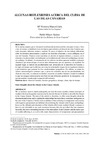Identificador persistente para citar o vincular este elemento:
https://accedacris.ulpgc.es/jspui/handle/10553/58655
| Campo DC | Valor | idioma |
|---|---|---|
| dc.contributor.author | Marzol Jaén, María Victoria | en_US |
| dc.contributor.author | Máyer Suárez, Pablo | en_US |
| dc.date.accessioned | 2019-12-16T18:50:48Z | - |
| dc.date.available | 2019-12-16T18:50:48Z | - |
| dc.date.issued | 2012 | en_US |
| dc.identifier.issn | 1139-7136 | en_US |
| dc.identifier.other | Dialnet | |
| dc.identifier.uri | https://accedacris.ulpgc.es/handle/10553/58655 | - |
| dc.description.abstract | De la misma manera que es frecuente la utilización incorrecta de los conceptos tiempo, clima y tipo de tiempo, es habitual el uso de tópicos para referirse al clima de las islas Canarias que, como docentes, debemos aclarar y matizar. Es, pues, el objetivo de este trabajo refl exionar sobre los términos mencionados y explicar sus estrechas relaciones, a veces ambiguas, en el caso de Canarias. Tópicos como suavidad, en alusión al régimen térmico, y escasez, en lo referente a la pluviosidad, son habituales en la defi nición del clima del archipiélago canario; sin embargo, la altitud y la orientación de los relieves insulares generan notables contrastes climáticos que desaconsejan el uso de tales afirmaciones por no ajustarse a la realidad. En segundo lugar, se indican las peculiaridades más destacadas de la atmósfera de Canarias y los tipos de tiempo que la afectan, así como los principales rasgos de los regímenes térmico y pluviométrico que generan los dos condicionantes geográfi cos. Por último, se tratan los valores meteorológicos extremos que, a pesar de constituir una de las peculiaridades del clima de estas islas, se achacan en muchas ocasiones al cambio climático cuando la realidad es que sus aciagas consecuencias son fruto de una defi ciente gestión de la emergencia y de una desmedida e inadecuada ocupación del territorio. | en_US |
| dc.description.abstract | We, as teachers, need to clarify and qualify not only the terms weather, climate and types of weather which are frequently used incorrectly, but also the use of clichés to describe the climate in the Canary Islands. The aim of this article is, therefore, to offer some thoughts about the aforementioned terms and to explain the relationships between them, sometimes ambiguous, in the case of the Canaries. Clichés such as mildness when referring to temperature and scarcity with regard to precipitation are habitual when defi ning the climate in the Canary archipelago; however, the altitude and orientation of the islands relief create marked climatic contrasts so that it is not advisable to use such assertions because they do not refl ect the true situation. Secondly, the most outstanding features of the atmosphere in the Canaries and the main types of weather affecting it, as well as the main characteristics of temperature and precipitation generated by the two geographical factors are discussed. Finally, the article deals with extreme meteorological values which, in spite of the fact that they are one of the peculiarities of the climate in this islands, are on many occasions held responsible for climate change although the truth is that their tragic consequences are the result of a mismanagement of the emergency and of a disproportionate and inappropriate occupation of the territory. | en_US |
| dc.language | spa | en_US |
| dc.relation.ispartof | Nimbus (Almería) | en_US |
| dc.source | Nimbus: Revista de climatología, meteorología y paisaje [ISSN 1139-7136] (29), p. 399-416 | en_US |
| dc.subject | 2502 Climatología | en_US |
| dc.subject.other | Climate in the Canaries | en_US |
| dc.subject.other | Geographical factors | en_US |
| dc.subject.other | Weather | en_US |
| dc.subject.other | Climate | en_US |
| dc.subject.other | Types of weather | en_US |
| dc.subject.other | Clima de Canarias | en_US |
| dc.subject.other | Factores geográficos | en_US |
| dc.subject.other | Tiempo | en_US |
| dc.subject.other | Clima | en_US |
| dc.subject.other | Tipo de tiempo | en_US |
| dc.title | Algunas reflexiones acerca del clima de las Islas Canarias | en_US |
| dc.type | info:eu-repo/semantics/article | en_US |
| dc.type | Article | en_US |
| dc.identifier.url | http://dialnet.unirioja.es/servlet/articulo?codigo=4376863 | - |
| dc.description.lastpage | 416 | - |
| dc.identifier.issue | 29 | - |
| dc.description.firstpage | 399 | - |
| dc.investigacion | Ciencias Sociales y Jurídicas | en_US |
| dc.type2 | Artículo | en_US |
| dc.contributor.authordialnetid | No ID | - |
| dc.contributor.authordialnetid | 173194 | - |
| dc.identifier.dialnet | 4376863ARTREV | - |
| dc.identifier.ulpgc | Sí | es |
| item.grantfulltext | open | - |
| item.fulltext | Con texto completo | - |
| crisitem.author.dept | GIR IOCAG: Geografía, Medio Ambiente y Tecnologías de la Información Geográfica | - |
| crisitem.author.dept | IU de Oceanografía y Cambio Global | - |
| crisitem.author.dept | Departamento de Geografía | - |
| crisitem.author.orcid | 0000-0003-1229-1477 | - |
| crisitem.author.parentorg | IU de Oceanografía y Cambio Global | - |
| crisitem.author.fullName | Máyer Suárez, Pablo Lucas | - |
| Colección: | Artículos | |
Visitas
561
actualizado el 31-ago-2024
Descargas
375
actualizado el 31-ago-2024
Google ScholarTM
Verifica
Comparte
Exporta metadatos
Los elementos en ULPGC accedaCRIS están protegidos por derechos de autor con todos los derechos reservados, a menos que se indique lo contrario.
